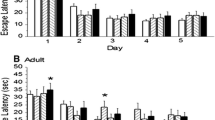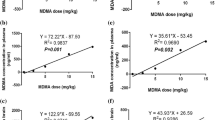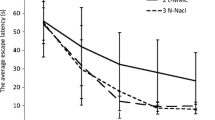Abstract
Acetamiprid (ACE) is one of the widely used neonicotinoid insecticides. In mammals, in spite of the low-affinity nAChRs, neurotoxic effects following the Acetamiprid exposure have recently been reported, which suggests some concerns regarding the impacts on the nervous system of mammals. This study aims to investigate the effect of Acetamiprid on spatial memory and possible vulnerability of hippocampal glutamatergic system following the Acetamiprid exposure. 10, 20, and 40 mg/kg doses of Acetamiprid were administered to male rats by gavage once per day for 28 days. The spatial memory was examined with the Morris water maze apparatus. The amount of Acetamiprid in the serum and hippocampus was measured. In addition, glutamate level and changes in the expression of NR1, NR2, and NR2B genes were measured in the hippocampus; also, the hippocampus tissue was histologically evaluated. A significant increase in training parameters which consist of escape latency and traveled distance was observed on the first and second day of training in Acetamiprid-treated groups (20 and 40 mg/kg) compared to the control group (p < 0.001). In the probe test, rats in all Acetamiprid-treated groups significantly spent less time in the target quadrant compared to the control group (p < 0.001). Acetamiprid concentration dose dependently increased in the serum and in the hippocampus followed by Acetamiprid exposure. In all Acetamiprid-treated groups, a significant reduction of glutamate level in the hippocampus was observed (p < 0.05). The reduction of NR1, NR2A, and NR2B gene expression in the hippocampus was observed at a dose of 20 mg/kg. The histological evaluation showed neural degeneration in the dentate gyrus area of the hippocampus at a dose of 40 mg/kg in the Acetamiprid-treated group. The results of the present study indicate that Acetamiprid impairs memory consolidation through the reduction of glutamate and the expression of NMDA receptor subunits in the hippocampus at low doses, along with the loss of neural cells in dentate gyrus at high dose.






Similar content being viewed by others
Data availability
Not applicable
Change history
11 April 2024
Editor's Note: Readers are alerted that the concerns have been raised with this article. Editorial action will be taken as appropriate once this matter is resolved and all parties have been given an opportunity to respond in full.
References
Aigner TG (1995) Pharmacology of memory: cholinergic—glutamatergic interactions. Curr Opin Neurobiol 5:155–160. https://doi.org/10.1016/0959-4388(95)80021-2
Bannerman DM (2009) Fractionating spatial memory with glutamate receptor subunit-knockout mice. Biochem Soc Trans 37:1323–1327. https://doi.org/10.1042/bst0371323
Bi H, Sze C-I (2002) N-Methyl-D-aspartate receptor subunit NR2A and NR2B messenger RNA levels are altered in the hippocampus and entorhinal cortex in Alzheimer’s disease Journal of the neurological sciences 200:11-18
Bott J-B, Muller M-A, Jackson J, Aubert J, Cassel J-C, Mathis C, Goutagny R (2016) Spatial reference memory is associated with modulation of theta–gamma coupling in the dentate gyrus cerebral cortex 26:3744–3753. doi:https://doi.org/10.1093/cercor/bhv177
Chakroun S, Ezzi L, Grissa I, Kerkeni E, Neffati F, Bhouri R, sallem A, Najjar MF, Hassine M, Mehdi M, Haouas Z, Ben Cheikh H (2016) Hematological, biochemical, and toxicopathic effects of subchronic acetamiprid toxicity in Wistar rats. Environ Sci Pollut Res 23:25191–25199
Cheng Q, Yakel JL (2015) The effect of α7 nicotinic receptor activation on glutamatergic transmission in the hippocampus. Biochem Pharmacol 97:439–444
Clayton DA, Mesches MH, Alvarez E, Bickford PC, Browning MD (2002) A hippocampal NR2B deficit can mimic age-related changes in long-term potentiation and spatial learning in the Fischer 344 rat J Neurosci 22:3628–3637
de Freitas Silva DM, Ferraz VP, Ribeiro ÂM (2009) Improved high-performance liquid chromatographic method for GABA and glutamate determination in regions of the rodent brain J Neurosci Methods 177:289–293
Dhouib IB et al. (2017) Neuroprotective effects of curcumin against acetamiprid-induced neurotoxicity and oxidative stress in the developing male rat cerebellum: biochemical, histological, and behavioral changes Environmental Science and Pollution Research 24:27515-27524
Han W, Tian Y, Shen X (2018) Human exposure to neonicotinoid insecticides and the evaluation of their potential toxicity: an overview Chemosphere 192:59–65. https://doi.org/10.1016/j.chemosphere.2017.10.149
Imamura T, Yanagawa Y, Nishikawa K, Matsumoto N, Sakamoto T (2010) Two cases of acute poisoning with acetamiprid in humans Clinical toxicology 48:851–853
Jarrard LE (1993) On the role of the hippocampus in learning and memory in the rat. Behav Neural Biol 60:9–26. https://doi.org/10.1016/0163-1047(93)90664-4
Jeschke P, Nauen R, Schindler M, Elbert A (2011) Overview of the status and global strategy for neonicotinoids Journal of Agricultural and Food Chemistry 59:2897–2908. doi:https://doi.org/10.1021/jf101303g
Kara M et al. (2015) Insecticide imidacloprid influences cognitive functions and alters learning performance and related gene expression in a rat model International journal of experimental pathology 96:332-337
Kumar A, Foster TC (2019) Alteration in NMDA receptor mediated glutamatergic neurotransmission in the hippocampus during senescence Neurochem Res 44:38–48
Lozada AF, Wang X, Gounko NV, Massey KA, Duan J, Liu Z, Berg DK (2012) Glutamatergic synapse formation is promoted by α7-containing nicotinic acetylcholine receptors Journal of neuroscience 32:7651-7661
Marchi M, Grilli M, Pittaluga AM (2015) Nicotinic modulation of glutamate receptor function at nerve terminal level: a fine-tuning of synaptic signals Front Pharmacol 6:89
Marmiroli P, Cavaletti G (2012) The glutamatergic neurotransmission in the central nervous system Curr Med Chem 19:1269–1276
Morris RG, Steele RJ, Bell JE, Martin SJ (2013) N-methyl-d-aspartate receptors, learning and memory: chronic intraventricular infusion of the NMDA receptor antagonist d-AP5 interacts directly with the neural mechanisms of spatial learning. Eur J Neurosci 37:700–717. https://doi.org/10.1111/ejn.12086
Morris RGM (2013) NMDA receptors and memory encoding. Neuropharmacology 74:32–40. https://doi.org/10.1016/j.neuropharm.2013.04.014
Nakayama A, Yoshida M, Kagawa N, Nagao T (2019) The neonicotinoids acetamiprid and imidacloprid impair neurogenesis and alter the microglial profile in the hippocampal dentate gyrus of mouse neonates J Appl Toxicol
OECD (2008) Test no. 407: repeated dose 28-day oral toxicity study in rodents. https://doi.org/10.1787/9789264070684-en
Özdemir HH, Kara M, Yumrutas O, Uckardes F, Eraslan E, Demir CF, Bal R (2014) Determination of the effects on learning and memory performance and related gene expressions of clothianidin in rat models Cogn Neurodyn 8:411–416
Reisi P, Alaei H, Babri S, Sharifi MR, Mohaddes G, Soleimannejad E (2009) Determination of the extracellular basal levels of glutamate and GABA at dentate gyrus of streptozotocin-induced diabetic rats Pathophysiology 16:63–66
Riedel G, Platt B, Micheau J (2003) Glutamate receptor function in learning and memory Behav Brain Res 140:1–47. doi:https://doi.org/10.1016/s0166-4328(02)00272-3
Soodi M, Saeidnia S, Sharifzadeh M, Hajimehdipoor H, Dashti A, Sepand MR, Moradi S (2016) Satureja bachtiarica ameliorate beta-amyloid induced memory impairment, oxidative stress and cholinergic deficit in animal model of Alzheimer’s disease Metabolic Brain Disease 31:395-404
Szyndler J et al. (2006) Effect of kindled seizures on rat behavior in water Morris maze test and amino acid concentrations in brain structures Pharmacol Rep 58:75
Terayama H et al. (2016) Acetamiprid accumulates in different amounts in murine brain regions Int J Environ Res Public Health 13:937
Tomizawa M, Casida JE (1999) Minor structural changes in nicotinoid insecticides confer differential subtype selectivity for mammalian nicotinic acetylcholine receptors British J Pharmacol 127:115–122
Tomizawa M, Casida JE (2005) Neonicotinoid insecticide toxicology: mechanisms of selective action Annu Rev Pharmacol Toxicol 45:247–268 doi:https://doi.org/10.1146/annurev.pharmtox.45.120403.095930
Xavier GF, Costa VCI (2009) Dentate gyrus and spatial behaviour Progress in Neuro-Psychopharmacology and Biological Psychiatry 33:762–773
Xavier GF, Oliveira-Filho FJ, Santos AM (1999) Dentate gyrus-selective colchicine lesion and disruption of performance in spatial tasks: difficulties in “place strategy” because of a lack of flexibility in the use of environmental cues? Hippocampus 9:668–681
Yakel JL (2014) Nicotinic ACh receptors in the hippocampal circuit; functional expression and role in synaptic plasticity. J Physiol 592:4147–4153. https://doi.org/10.1113/jphysiol.2014.273896
Yamada T, Takahashi H, Hatano R (1999) A novel insecticide, acetamiprid. Nicotinoid insecticides and the nicotinic acetylcholine receptor. Springer, In, pp 149–176
Zappettini S, Grilli M, Salamone A, Fedele E, Marchi M (2010) Pre-synaptic nicotinic receptors evoke endogenous glutamate and aspartate release from hippocampal synaptosomes by way of distinct coupling mechanisms Br J Pharmacol 161:1161–1171
Zheng M et al. (2020) Metabolic disturbance in hippocampus and liver of mice: a primary response to imidacloprid exposure Sci Rep 10:1-12
Author information
Authors and Affiliations
Contributions
MS designed the study and interpreted the results and was a major contributor in writing the manuscript. MSh carried out the experiments and collect the data. SS was involved in the gene expression experiments. AO was involved in histological evaluation of the brain sections. All authors read and approved the final manuscript.
Corresponding author
Ethics declarations
Conflict of interest
The author declares that they have no conflict of interest.
Ethics approval and consent to participate
All experimental procedures such as working with animals and tissue collection were approved by the ethical committee of the Tarbiat Modares University (ethical code: IR.MODARES.REC.1397.115).
Consent for publication
Not applicable
Additional information
Responsible Editor: Ludek Blaha
Publisher’s note
Springer Nature remains neutral with regard to jurisdictional claims in published maps and institutional affiliations.
Rights and permissions
Springer Nature or its licensor (e.g. a society or other partner) holds exclusive rights to this article under a publishing agreement with the author(s) or other rightsholder(s); author self-archiving of the accepted manuscript version of this article is solely governed by the terms of such publishing agreement and applicable law.
About this article
Cite this article
Shamsi, M., Soodi, M., Shahbazi, S. et al. Effect of Acetamiprid on spatial memory and hippocampal glutamatergic system. Environ Sci Pollut Res 28, 27933–27941 (2021). https://doi.org/10.1007/s11356-020-12314-6
Received:
Accepted:
Published:
Issue Date:
DOI: https://doi.org/10.1007/s11356-020-12314-6




